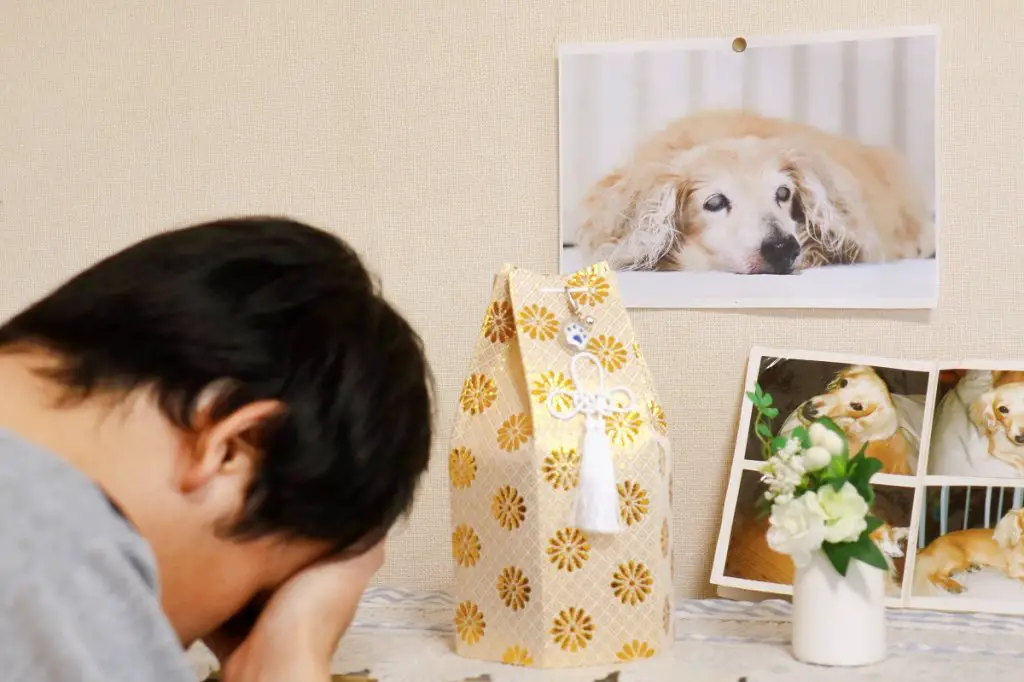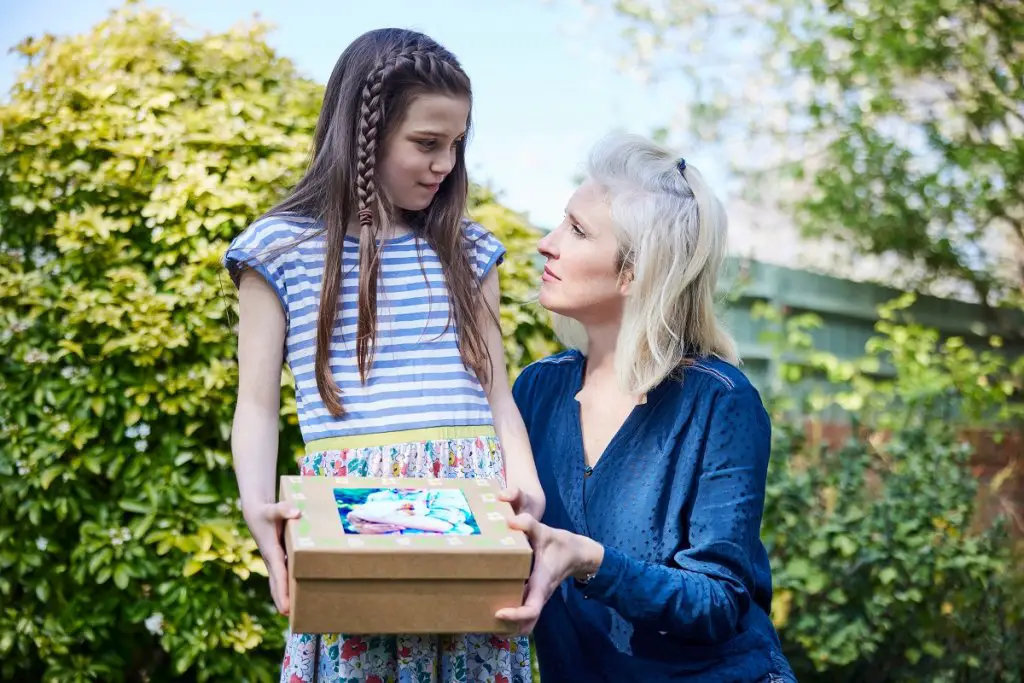Losing a pet can be difficult in a family with children as they have little experience dealing with loss. Children have unconditional love for furry members of the family and may not know how to handle the loss of a family pet. Here are some way to help them through this difficult time.
The death of a beloved pet can feel like losing a family member. As adult pet owners, it’s something we prepare ourselves for from the beginning, knowing we will likely outlive every pet we bring into our homes. But it’s often a child’s first experience with death, and it can be challenging to navigate.

Table of Contents
Why Is Losing A Pet So Hard On Children?
Because children do not have experience with death, it can be very confusing to them. Young children under five do not understand the permanence of death. They may think their pet is gone for a short time but will return. For older children who have known a pet their whole (short) life, it can feel like the end of the world. In addition to being sad, it’s normal for them to be in denial or to feel angry and resentful. They might lash out at family members as they go through the stages of grief. It’s important for caregivers to monitor their mental health and have open, honest lines of communication to help them through the process.
Like adults, children tend to have an easier time accepting the loss of a pet if they can plan for it. For example, when getting a hamster or goldfish, they know the pets will naturally have a shorter lifespan than a cat or a dog. Similarly, if a pet was ill, you could prepare your child by talking about euthanasia as a means to ease their suffering. But when a pet dies suddenly or tragically, it tends to be more shocking and harder for children to process.
What can be the scariest part for children is the realization that if an animal can die, so can mommy and daddy.
What Do You Say To Your Kids After The Loss Of A Family Pet?
The best thing you can do when a family pet dies is to be honest with your children. Tell them that it’s ok to talk about death and the emotions they’re feeling. They may not immediately feel sad; instead, they may cope with their grief through play and by pretending the pet is still alive. Let them experience grief in their own way. Follow their lead and answer their questions when they have them, and don’t try to force them to talk about their feelings when they’re not ready.
Some kids may think their pet’s death is their fault. That if they’d somehow loved him more or given him more food or belly rubs, he’d still be here. If your child really did cause the pet’s death (i.e., left the door open and the dog ran into the road), reassure your child that accidents happen and it’s no one’s fault. Remind them that death is a natural part of life that happens to everyone – whether through old age, illness, or an accident.
How Long Does The Grief Of Losing A Pet Last?
Everyone experiences grief in their own way. Some children are more resilient than others and may seem unfazed until it suddenly hits them months later. Others grieve hard and fast and are over the loss quickly. For some children, the loss of their furry best friend can linger for years. For pets that were truly part of the family, it can feel like the death of a loved one, the same as losing a brother, son, or father.
After the death of your pet, it may also be helpful for your family to join a pet loss support group. You can work directly with a professional therapist to cope, or you can find a group of people in similar situations to talk to. Sometimes sharing your personal experience with the loss of a pet, and hearing others’ stories, can help you and your children feel less alone.
There is no set timeframe for the grieving process. Monitor your children, talk when they want to, and watch for signs that they’re starting to move on.

What Is The Best Way To Say Goodbye To A Pet?
Goodbye rituals tend to be helpful for children. Talk to your children and decide as a family if your pet will be buried or cremated, then plan a funeral or memorial service. Invite your children to share a poem or song in honor of your pet’s memory. Just as with a funeral for a person, the service should be a celebration of your pet’s life. You can create a headstone, cross, or other type of memorial to place in your yard. Have children help paint it, add their handprints, or write a short epitaph on it.
Depending on your beliefs, you can share the story of the Rainbow Bridge. The Rainbow Bridge is a mythical connection for pets to travel from Earth to Heaven. On the other side are lush green fields and plenty of water, food, and sunshine where pets happily play together and wait to be reunited with their families someday.
After you’ve said your goodbyes, take some time to focus on self-care. Treat your family to ice cream or a movie night in. Focus on your children’s well-being and make sure they’re doing ok mentally and emotionally.

What Is A Good Way To Memorialize A Pet?
There are countless ways to ensure your pet lives on in your family’s memories fur-ever:
- Pet collar frame
- Cremation ashes ring
- Personalized garden stone
- Custom pet portrait
- Pet urn vase
- Biodegradable pod casket (consider planting a tree alongside it!)
- Portrait name necklace
You can also look through photos and gather stories and memories to create a family scrapbook or use a photo site to have a book custom printed. .
For more ideas, see Pet Memorial Gifts: 15 Great Pet Loss Gifts.
How Do You Know If You Are Ready To Get A New Pet?
Adding a new pet to your family after one dies can help with the healing process. Or, it can be a painful reminder of the loss of a beloved pet. You don’t want your grief to overshadow the bonding you will need to do with a new pet. Just as every member of your family will grieve differently, everyone will be ready to adopt a new pet in their own time. Watch for signs that everyone has dealt with the pain from your last pet’s death before rushing to get a new one.
When you do decide to get a new pet, don’t set any unfair expectations on them by comparing them to your old pet. Every dog or cat has its own unique personality, and your family will need to learn and accept them for who they are, just as you did with your last pet.

What Are 20 Things You Can Say To Your Kids When A Pet Dies?
It can be hard to know how to talk to children about death, especially when it’s the death of a beloved pet. The best thing is to keep it simple and honest while acknowledging that anything your child is feeling is valid. Here are some ideas if you are feeling stuck:
- I’m so sorry for the loss of your pet.
- I know how close you were to [pet name]. I’m sorry.
- Losing your best friend isn’t easy.
- I know losing [pet name] makes your heart hurt.
- [pet name] ‘s has crossed the Rainbow Bridge, and you will see them again someday.
- It’s ok to feel sad/angry/etc. All of those feelings are normal.
- I’m sorry you have to learn about death by losing [pet name].
- [pet name] ‘s memory will live on forever because you loved them so much.
- I know our house will feel empty without [pet name].
- I’m here if you want to talk.
- I’m here for you if you need anything.
- It’s ok to cry or get mad.
- You know you can ask me anything, and I will be honest with you.
- No one could have loved [pet name] more than you. They were lucky to have you.
- You made [pet name] very happy for the years he was with you.
- It’s ok to be sad, but memories of [pet name] ‘s sweet cuddles and purrs can comfort you.
- [pet name] was a one-of-a-kind dog/cat. We were so lucky to have them be part of our family.
- When you feel sad and miss [pet name], think of all the fun times you had with them.
- Does it make you feel better thinking of what [pet name] might be doing in Heaven right now?
- Even grown-ups feel sad when a pet dies.

